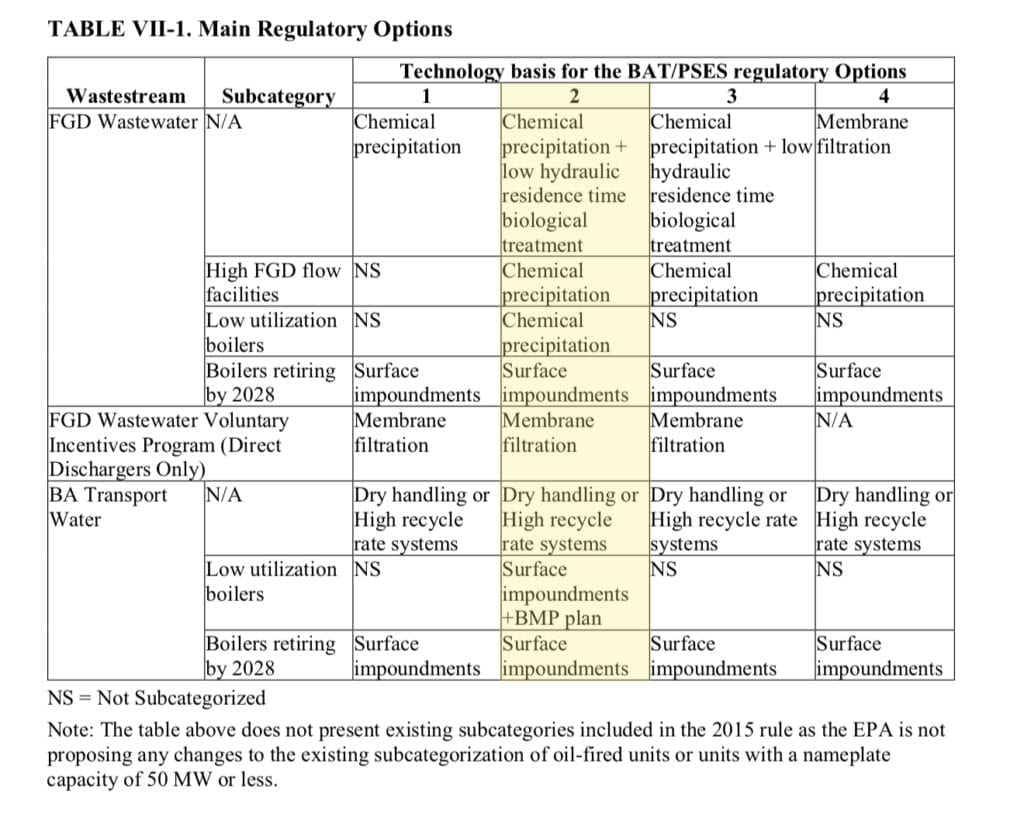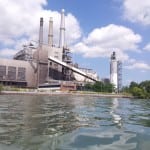The Environmental Protection Agency (EPA) has issued long-awaited proposed revisions of two 2015 Obama-era rules that apply to effluent limitations guidelines (ELGs) for steam electric power plants and coal combustion residuals (CCR) management by electric utilities.
The agency coordinated the release of the two related revisions, which apply overwhelmingly to coal-fired steam power plants, after more than 75 days of regulatory review at the White House’s Office of Budget and Management. Industry, which must comply with the rules when they are finalized—possibly in August 2020—has expressed consternation at the proposals’ delay, noting regulatory uncertainty is disrupting planning. Before they can be finalized, however, the rules will be subjected to two concurrent 60-day public comment periods, which will include only a single virtual public hearing per rule.
The EPA pegged the lengthy revisions to its “open and inclusive approach to rule making” to reconsider the two 2015 rules, acknowledging part of the delay was due in part to the CCR rule, which required OMB review “because it raises novel legal or policy issues.” But in a news release bedecked with supportive quotes from coal-friendly states, EPA Administrator Andrew Wheeler said the 2015 rules had “placed heavy burdens on electricity producers across the country.” The proposed rules are more “cost-effective,” and would “promote transparency” for power generators and consumers, he said. “These proposed revisions support the Trump Administration’s commitment to responsible, reasonable regulations by taking a commonsense approach, which also protects public health and the environment,” he added.
ELG Rule Revised Mostly as Expected
The newly proposed ELG rule seeks to amend the Obama administration’s November 2015-finalized rule, which sought to amend an ELG rule last updated in 1982 by setting the first federal limits on levels of toxic metals in wastewater that can be discharged from existing coal, gas, oil, and nuclear plants.
But rather than overhauling the entire rule, the EPA’s 197-page Nov. 4 proposal only revises specific aspects of the 2015 final rule.
- It establishes effluent limitations based on best available technology economically available (BAT) for two only two categories—which, it notes, are facilities’ “largest sources of wastewater”: flue gas desulfurization (FGD) wastewater, and bottom ash transport water.
- For FGD wastewater, it establishes two sets of BAT limitations: a numeric effluent limit based on total suspended solids (TSS) in FGD wastewater discharge; and numeric limit on mercury, arsenic, selenium, and nitrate/nitrite as nitrogen.
- For bottom ash transport water, it also establishes a TSS numeric effluent limitation, but it adds a “not-to-exceed 10% volumetric purge limitation. As significantly, the rule eliminates the zero-discharge standard for bottom ash water and gives facilities a “discharge allowance.”
- However, it also adds and sets requirements for new subcategories—including high-flow facilities (discharging FGD wastewater flows of more than 4 million gallons per day), low utilization boilers, (with net generation of below 876 GWh per year), and boilers retiring by 2028. But it does not seek to change requirements for existing subcategories, such as for oil-fired boilers and generating units below 50 MW.
- Importantly, it also extends compliance with the new rule on or after Nov. 1, 2020, but no later than Dec. 31, 2023, for bottom ash transport water and Dec. 31, 2025, for FGD wastewater.
- As notably—and as a bonus for power generators—the proposed rule establishes a “voluntary incentives program,” which essentially gives facilities until December 2028 to implement the new limits, if they adopt “additional process changes and controls” that achieve stricter limitations on mercury, arsenic, selenium, nitrate/nitrite, bromide, and total dissolved solids in FGD wastewater.
- For each of these categories and subcategories, it identifies options that could qualify as BAT technology basis/ pretreatment standards for existing sources (PSES), noting each “successive option from Option 1 to 4 would achieve a greater reduction in FGD wastewater pollution discharges.” However, though it asked for comments on all aspects of the proposal, including the options, in light of criteria specified in the Clean Water Act, it proposed to establish BAT effluent limitations based on technologies described in Option 2.

Also notable is that for the proposal, the EPA considered two FGD wastewater treatment technologies not included in the 2015 rule: low hydraulic residence time biological reduction (LRTR) and membrane filtration. LRTR is a biological treatment system that targets removal of selenium and nitrate/nitrite using fixed-film bioreactors in smaller, more compact reaction vessels than those used in the biological treatment system evaluated in the 2015 rule (which is known as high residence time biological reduction (HRTR). Membrane filtration systems typically combine pretreatment with potential scaling agents and a membrane technology to remove particulate and dissolved pollutants from wastewater. However, the EPA also said that it could not conclude that membrane filtration is “technologically available nationwide at this time,” though it noted it may become available nationwide by 2028, which is why it included it in the voluntary incentives program.
Extended Deadlines for CCR Facilities
The newly proposed 94-page CCR rule—one of many coal ash rules on the EPA’s regulatory agenda—is titled “A Holistic Approach to Closure Part A: Deadline to Initiate Closure.” It essentially responds to an August 2018 D.C. Circuit decision (Utility Solid Waste Activities Group, et al v. EPA), which the federal court issued a month after the EPA finalized the first of two rules designed to overhaul the Obama administration’s April 2015-issued coal ash rule and better align it to potential ELG rule revisions.
But the rule, known as the Phase 1 rule, weakened requirements for managing coal ash storage areas, allowed states to suspend groundwater monitoring if no leaks are detected, and delayed pond closure deadlines until October 2020—about 18 more months compared to the 2015 rule. The court, however, remanded the rule to the EPA in August 2018, striking down provisions of the 2015 rule that allowed unlined and clay-lined impoundments to receive coal ash and provisions that exempted inactive impoundments.
These are key revisions proposed in the Nov. 4-issued CCR rule, which the EPA said could potentially affect 522 units at 230 coal-fired facilities nationwide.
- It would change the classification of compacted-soil lined (or “clay-lined”) surface impoundments from “lined” to “unlined,” reflecting the federal court’s order.
- It would bring forward deadlines for CCR units to stop receiving (or “cease receipt”) of coal ash and initiate closure—because they are unlined or clay-lined or because they failed location standards—to Aug. 31, 2020. That’s only about two months before the current deadline of Oct. 31, 2020.
- However, it would also give CCR facility owners more time to develop “alternate capacity” to manage waste streams (both CCR and non-CCR) to meet close surface impoundments and meet these deadlines. A short-term extension would give facilities until Nov. 30, 2020.
- But if a facility can show that the continued operation pose fewer risks than if forced to close on the shorter time scheduled, the EPA or participating state could give it up to five years—until October 2023—to close the impoundment.
- Finally, the EPA proposes a separate set of deadlines for power plant owners that are planning to stop operating coal-fired boilers—because they no longer have to find “alternate capacity.” The rule requires that for surface impoundments smaller than 40 acres, boilers must stop operating and the impoundment close by October 2023; for impoundments larger than 40 acres, that deadline is extended to October 2028. And for landfills, the EPA will require closure by April 2021.
Cost Comparison
According to the EPA, compared to the 2015 rule, the Nov. 4 ELG proposal will save industry about $175 million annually in pre-tax compliance costs and $137 million annually in social costs. It pegs the reductions on “less costly FGD wastewater technologies” that could be used to achieve the proposed relaxed selenium limitation and “less costly” bottom ash transport water technologies, because the proposed rule eliminates the 2015-rule’s requirement that zero pollutants could be discharged in bottom ash transport water.
The agency also factors in the two-year extension of compliance timeframes, noting more time would give generators more flexibility to comply. “The EPA also believes that participation in the voluntary incentive program would further reduce the pollutants that these steam electric facilities discharge in FGD wastewater by about 105 million pounds per year,” it said.
Meanwhile, it said the proposed CCR rule could result in a “net cost savings” amounting to an annualized $39.5 million per year. That’s one reason, unlike the ELG rule, it is not considered an “economically significant action.” The EPA also deemed the action “not a significant energy action,” noting it is “not likely to have a significant adverse effect on the supply, distribution or use of energy.”
Predictable Reactions
Reactions to the EPA’s two new measures were slow to trickle in on Monday, as stakeholders pored through the nearly 300 pages of regulatory material.
Predictably, however, America’s Power (ACCCE), the nation’s only trade organization whose sole mission is to advocate at the federal and state levels on behalf of coal-fueled electricity and the coal fleet, applauded the rules. The group has warned that since 2010, 40%, or 664 coal-fired generating units in 43 states—a total 125.7 GW—have retired or announced plans to retire through 2030. Last year about 82.2 GW of coal power retired, and this year and in 2020, an additional 16.6 GW will retire. ACCCE attributes the coal power sector’s troubles to a number of factors: an aging fleet; cutthroat competition in wholesale electricity markets, and EPA regulations and policies. EPA-caused retirements through 2030 represent more than 78 GW of retirements. Of this figure, nearly 60 GW had already retired by the end of 2018, it said.
“The 2015 CCR and ELG rules, as well as court decisions, could have had many adverse repercussions on the electric power sector, including the forced closure or idling of coal-fired power plants that are necessary for reliable and affordable electricity,” ACCCE President and CEO Michelle Bloodworth told POWER on Monday. “Based on what we know, EPA’s proposals appear to include enough flexibility to avoid these adverse consequences while, at the same time, protecting public health and the environment. We appreciate EPA taking this step and look forward to providing additional feedback on these proposals as they move through the regulatory process.”
Environmental groups also responded, vowing to challenge the rules in court. “It is outrageous that Trump’s team is so beholden to polluters that they are willing to let power plants continue to dump lead, mercury, chromium and other dangerous chemicals into our water supply to preserve every last cent of their profits,” said Thom Cmar, deputy managing attorney of the coal program at the environmental law firm Earthjustice. “If it weren’t for the reckless rollbacks under Donald Trump, there would be no more toxic chemicals being added today to ponds across the U.S. that are leaking poison into our water. Earthjustice and our partners will fight this every step of the way.”
—Sonal Patel is a POWER senior associate editor (@sonalcpatel, @POWERmagazine).










